“Alone we can do so little, together we can do so much”
~ Helen Keller
Collaboration is one of the most powerful tools we have to achieve a successful outcome. It is a way of bringing minds together, generating solutions that build upon multiple perspectives and experiences. For many, simply being engaged on the same task with others can boost motivation. Building off of others energy. Strengthening trust. Learning new ideas. Feeling heard.
While you may whole heartedly agree with this; you may also be thinking…
As much as I would like to collaborate, it often becomes a tremendous drain on time to bring in another person.
At the pace we have to move, we don’t have time to collaborate.
Whenever I involve others, everything becomes more complicated.
Unfortunately many of us try to go it alone or tell others what they need to do. We don’t utilize the brainpower on our team or draw from others energy. And in doing so, we lose a huge opportunity to engage, motivate, and ultimately access different points of view that may be critical to creating an effective solution.
I totally understand that collaboration is much easier to talk about than to execute. Like communication, it is more of an art than a science. It requires knowledge, skill, and practice.
It does not just happen … and it can go terribly wrong if not facilitated properly.
Have you ever gone into a conversation wanting to collaborate and found that the other person brought up an issue you weren’t even planning on discussing? Or have you found yourself going in circles, listening to everyone’s point of view, while you were brought no closer to resolution?
Do you think collaboration is one of those “nice to have” conversations, but not necessary in the work you are doing?
I challenge you to look at collaboration as a necessity. In a Forbes article by Joshua-Michéle Ross he discusses why collaboration is more important now than ever before stating … “Teams are global, the workplace is virtual. The more multicultural, multilingual, multinational you are, the harder it is to achieve knowledge exchange and timely decision-making. You may not be in a global organization but telephone, email, telepresence and real-time messaging have allowed the under-one-roof workplace to diffuse into a loosely-joined workforce. Even when in close proximity we may not be together. How many of us send email to a colleague down the hall?. As our organizations slowly diffuse across timezones and space, collaboration is a glue to keep people together.”
Collaboration is a social activity that requires a certain level of emotional intelligence ensuring that choices are made to encourage and support a two-way productive conversation.
Using my 5 tips for successful collaboration, you will be amazed by what transpires!
IDENTIFY THE PURPOSE OF YOUR CONVERSATION
I continually share with my clients that if they don’t know where they are going…they quite frankly, could end up anywhere. When you open a collaborative, joint conversation, rather than a “do as I say” kind of interaction, then you must have a clear vision on what you are trying to accomplish. For if you don’t have this type of clarity, you will easily be brought down paths from which you won’t be able to get off. It is essential that you are clear on your expected outcomes and purpose of the conversation, while removing all attachment to how it is achieved.
INVITE THE OTHER PERSON TO PARTICIPATE
If you want the person to feel welcome to share ideas and trust they will be heard, then it is essential to invite them into the conversation. So many of us have gotten into the habit of “cutting to the chase” and leading a conversation with our own ideas or opinions. While your idea may be completely relevant and may in fact move them forward faster, you have just set the stage that you are going to tell them what to do. And if this is your natural tendency, your team members are accustomed to listening rather than generating ideas. If you want to create collaborative energy, you will be much more successful if you open a conversation with “I would really like to hear your ideas on this matter and then if I have a unique perspective to share, I will do that as well. I would like to use this opportunity for us to collaboratively come up with the best solution for the team and situation.” rather than “when I had a similar challenge, this is how I handled it…” Right from the start it is important to set the stage for two-way, idea generating conversation.
LEAD WITH YOUR QUESTIONS, NOT YOUR ANSWERS
Upon entering a focused, collaborative conversation it is always more effective to lead with your questions rather than your ideas. It builds trust. It creates excitement. It generates a powerful solution where both you and the other person are bought in. Let’s face it, in this era of internet access, answers are the easy part. It is the questions that create excitement and will allow you to generate new and innovative ideas. I recently wrote a blog, The Question Enlightens, in which I share methods to guide a conversation knowing that it is not your answers that will shed the light, but the questions that you ask.
PRAISE INNOVATIVE IDEAS
According to a study outlined in the Harvard Business Review, when we face criticism or feel minimized, our bodies produce higher levels of cortisol. This is a hormone that shuts down the thinking center of our brains and activates conflict aversion and protection behaviors. During these times we become more reactive and sensitive and often perceive even greater judgment and negativity than actually exists. On the other hand, when we receive praise it also creates a chemical within our body, oxytocin. This is a feel-good hormone that elevates our ability to communicate, collaborate and trust others. As you pay attention to the impact your behaviors have on the chemistry of the conversation, you can make more deliberate choices to stimulate thinking and bring out the best in others…ultimately leading to your desired results.
ESTABLISH CLEAR ACCOUNTABILITY AND OWNERSHIP
Collaboration can easily fall apart if you only focus on the generation of ideas and lose sight of accountability. During this energizing process it is critical to periodically delve into the tactics, assigning ownership and timelines. Simply identifying who is going to do what and by when. For if you don’t do this, you will ultimately waste time and find yourself in the same conversation again and again.
The most effective leaders are able to strike a balance between focus and collaboration. Utilizing the creative energy that is generated from two or more people focusing on a common goal. Because after all, together we can achieve so much more!
If you are interested in assessing your own ability to lead collaborative conversation, schedule a complementary Deep Dive Session so that we can explore where you are now and where you would like to be.




